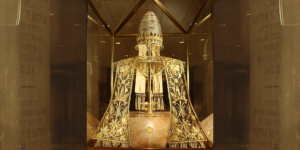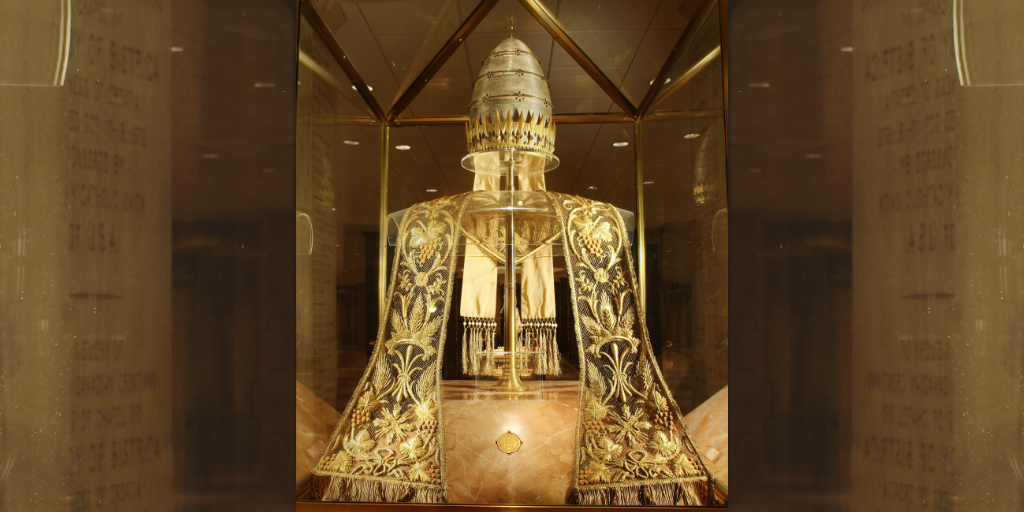
With their iconic beehive shape, delicate gems, and intricately crafted crowns, papal tiaras were part of the ceremonial papal attire for centuries. But how did the papal tiara originate, and what is its significance in Church tradition?
In today’s post, we invite you to discover a brief history of the papal tiara and where you can view one of these magnificent headdresses at the National Shrine.
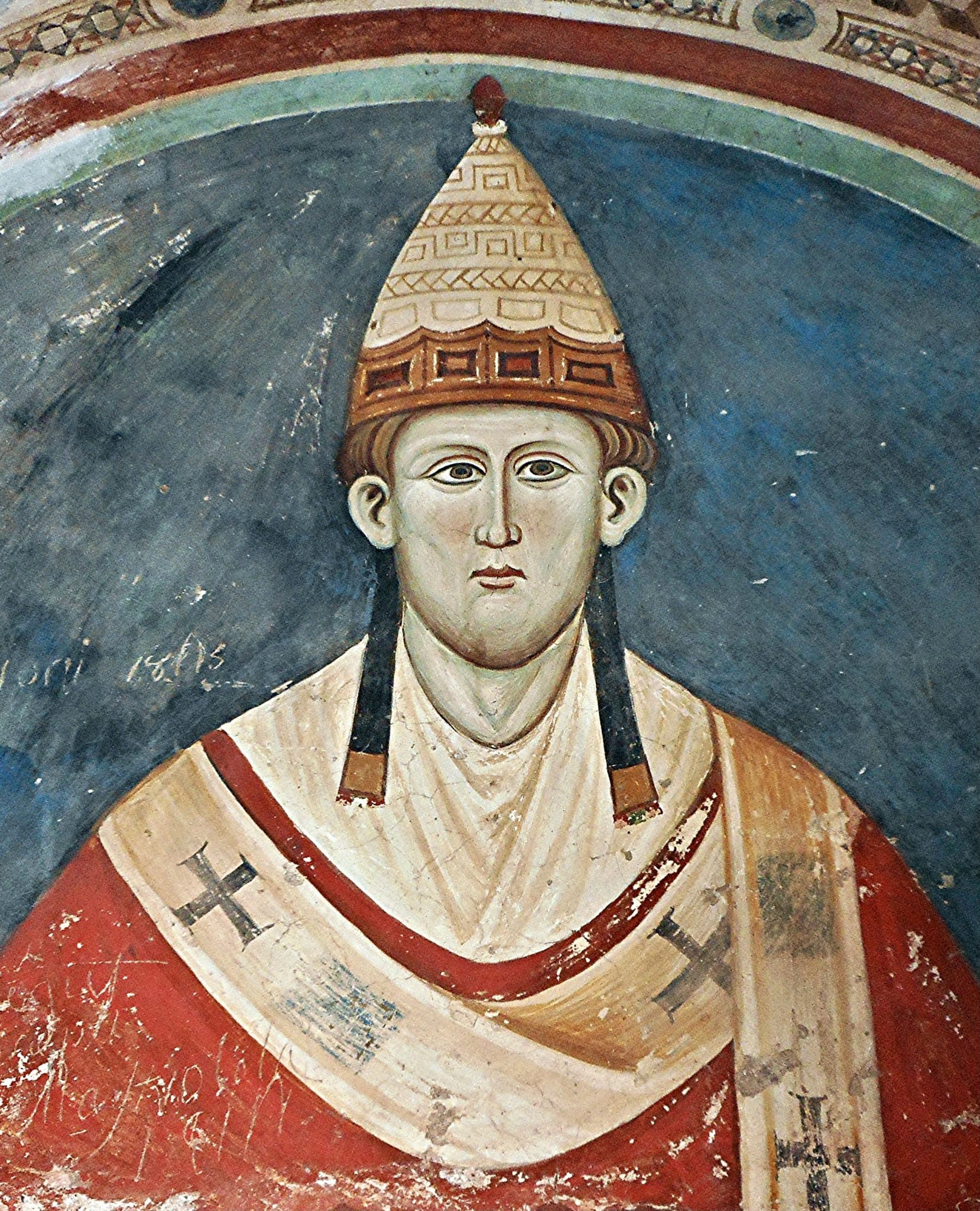
The Origins and Evolution of the Papal Tiara
Historic records reveal that ornamental papal headwear was worn as early as the 4th century. Initial versions of the papal tiara may have been inspired by the Phrygian cap, “a tall conical headdress that was worn in the Greco-Roman era,” as well as the camelaucum, a hat worn by Byzantine courtiers. The earliest known reference to the papal camelaucum can be found in the writings of Pope Constantine, who reigned in the early 700s, although the phrase “papal tiara” was not used until the 1100s.
Over the centuries, the tiara continued to evolve, taking on greater complexity and splendor. Papal coin designs indicate that a single circlet, or crown, was likely added to the tiara in the early 900s, followed by a second crown later that century. Precious gems were also incorporated into the design during the 900s by Pope Boniface VII, and lappets were added sometime in the 13th century. It wasn’t until the 14th century that a third crown was added to the headdress, resulting in the traditional papal tiara that we recognize today.
The Significance and Value of the Tiara
The choices of structure and material for the traditional papal tiara carry deeper significance; typically, the papal tiara was made from silver or gold materials, symbolizing the pope’s position of power and authority. Some were quite costly: one belonging to Pope Paul II contained gemstones worth approximately 200,000 florins in the 1460s – the equivalent of over 22 million U.S. dollars today! While it is unclear if there was a specific symbolic meaning tied to the first two crowns, today, the three crowns on the tiara represent the threefold papal powers: to teach, to govern, and to sanctify. Since the 1500s, many tiaras have also featured a globe and a cross at their tip. Although most tiaras were commissioned by the Pope, some were the gifts of foreign monarchs and dignitaries.
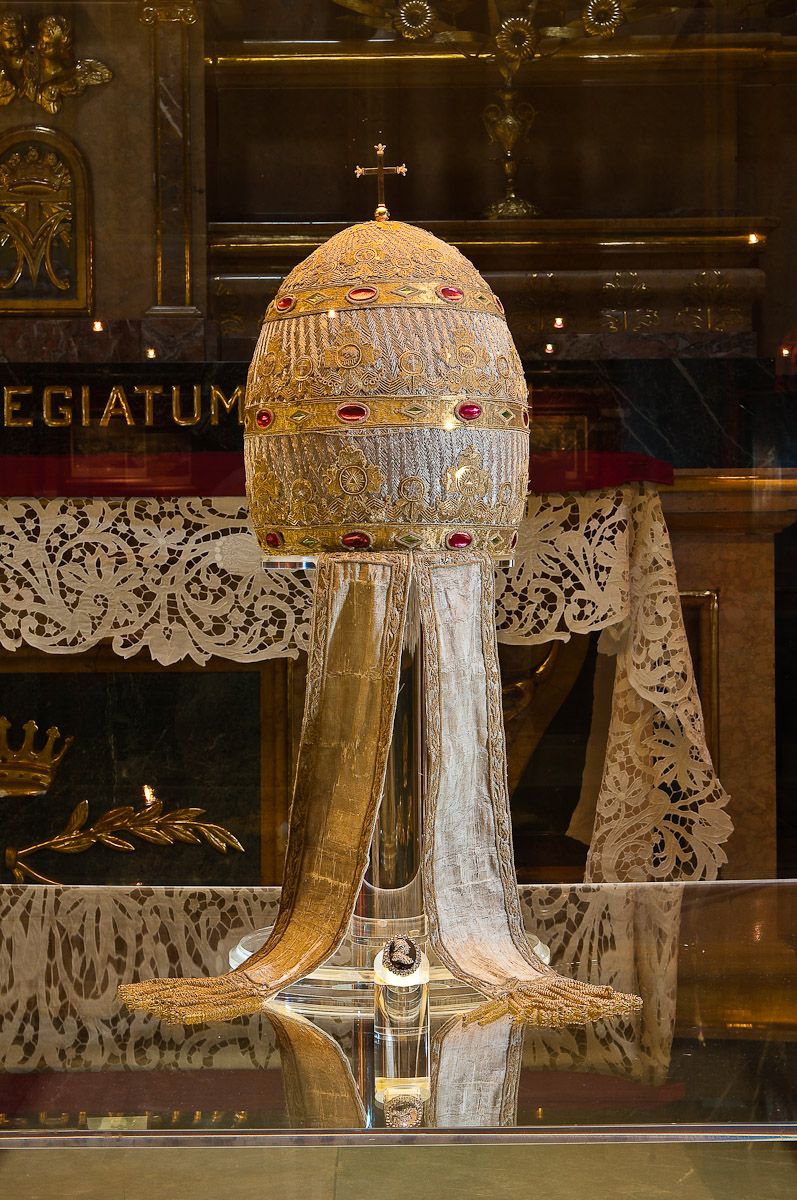
The Napoleonic Occupation of Rome and the Papal Tiara
One key event in papal tiara history took place during the Napoleonic occupation of Rome in the late 1790s, when the French Army seized control of the papal treasury. Upon discovering the papal tiaras, the troops melted down three of them and tore a 400-carat emerald from another, sending the jewel home to Paris.
In 1800, due to the French Army’s continued presence in Rome, the papal coronation ceremony was performed in Venice, and Pope Pius VII was unable to use one of the existing papal tiaras. Instead, he donned a papier-mâché tiara adorned with jewels borrowed from local noble families! Later in his reign, Pope Pius VII received a tiara as a gift from Napoleon, and during World War I, Pope Benedict XV sold the gems from that tiara to aid those impacted by the war.
The Abandonment of the Papal Tiara
The last pope to wear a tiara was Pope Paul VI in the 1960s. A few months after his coronation ceremony in June of 1963, he chose to donate his coronation tiara to raise funds for charity. He never wore a tiara again, opting to wear a miter at all future ceremonial events. While all succeeding popes have been given their own papal tiaras, each of them has followed Pope Paul VI’s example, choosing to only wear miters during Church ceremonies.
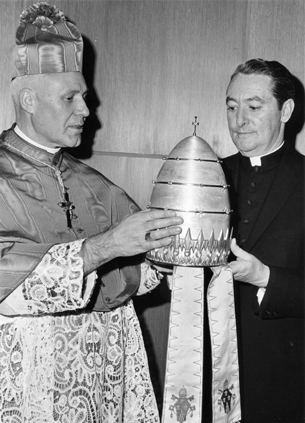
The Papal Tiara at the National Shrine
Here at the National Shrine, we are honored to provide a home for Pope Paul VI’s coronation tiara – the only papal coronation tiara to be displayed outside of the Vatican, and the last one officially worn.
The tiara was made by Scuola Beato Angelico, Milan, Italy, and was a gift of the people of Milan to their former archbishop. It is made of spun-pierced silver metal with a Florentine texturing, encircled by three yellow gold bands. Each band is set with precious gems. The tiara weighs approximately 10 ounces.
Two silk lappets edged with gold thread, 20 cultured pearls, and adorned with two hand-embroidered coats-of-arms of Paul VI provide the final touch.
*The first and second images are public domain, accessed via Wikimedia Commons.
Sources:
Rohling, Geraldine M., PhD, MAEd. The Basilica of the National Shrine of the Immaculate Conception: Guide and Tour Book. Washington, D.C.: Basilica of the National Shrine of the Immaculate Conception, 2018.
———. “Coronation Tiara of Paul VI,” Mary’s Shrine, Vol. 76, No. 1 (Spring/Summer 2015): 8-12.
“The Last Tiara Used in a Papal Coronation (Made by Scuola Beato Angelico in Milan),” Liturgical Arts Journal.
“The Tiaras of the Popes: The Papier-Mâché Tiara of Pius VII,” Liturgical Arts Journal.
“Tiara,” New Advent.
“Tiaras of the Popes: Three Tiaras of Pope Pius IX,” Liturgical Arts Journal.
“Triregnum: Papal Dress,” Encyclopædia Britannica.
“Whatever happened to the papal tiara?” The Catholic Herald.

